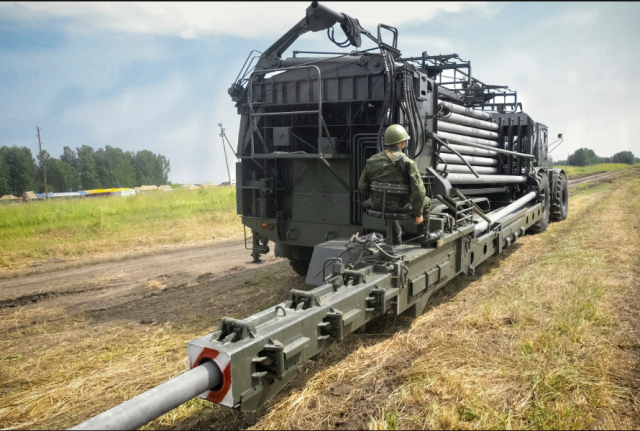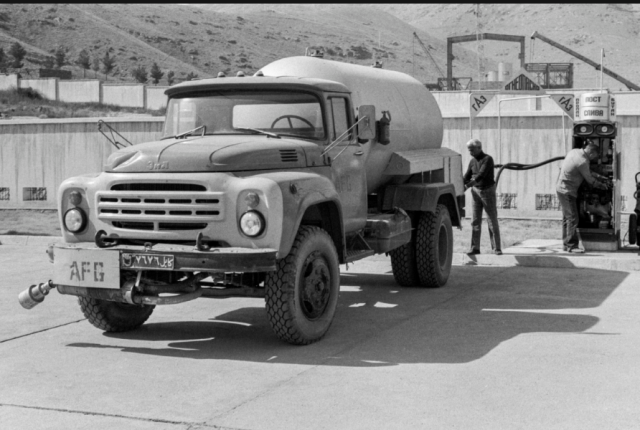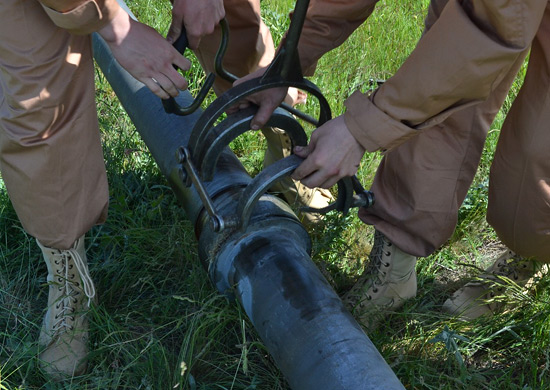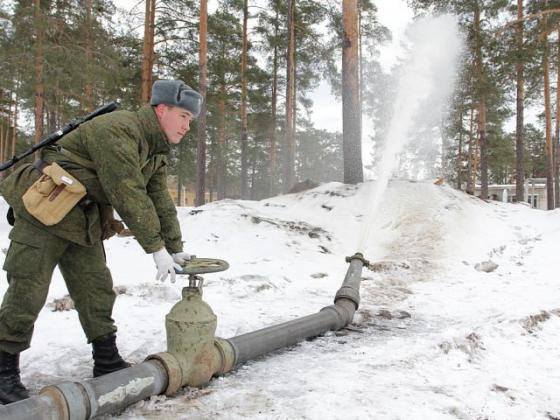On January 14, the Russian army will celebrate the Day of Pipeline Troops — special troops of the Rear of the Armed Forces of the Russian Federation. The holiday was established by decree of Russian President Vladimir Putin at the end of 2021. However, the units providing troops with fuel have been around for decades. They supplied fuel to besieged Leningrad, pulled highways in the mountains of Afghanistan under fire from gangs and watered Crimea, blocked by Ukraine. TASS — about the history of combat "trumpeters"
In the 1930s, the Workers' and Peasants' Red Army (Red Army) began to arm itself massively with tanks, aircraft, armored vehicles, artillery tractors, and motor vehicles. All these combat vehicles required fuel. Therefore, petroleum products became one of the most important material assets of the army and there was a search for effective ways to supply troops with fuel. High-performance pipelines could not be better suited for this.
The project of the first field trunk pipeline in military history belongs to our country. In 1933, by order of the Fuel and Lubricants Supply Department of the Workers' and Peasants' Red Army, the Nefteprovodstroy Trust developed a collapsible highway with a length of 100 km, along which 350 tons of fuel could be pumped per day. The fighting of the Red Army on the eve of the Great Patriotic War confirmed that the army needs means of delivering fuel and lubricants over long distances.
One of the important episodes in the history of military pipelines was a unique 35 km long fuel line, most of which passed under water — along the bottom of Lake Ladoga. Its commissioning on June 18, 1942 became the first domestic experience of laying a field pipeline crossing a large water barrier. A steel pipeline with a diameter of 100 mm, laid in just 41 days, was designed to pump 300-350 tons of fuel per day. Various types of fuel were alternately pumped through it, the total volume of which amounted to almost 50 thousand tons. Together with the famous Highway of Life, the highway helped Leningrad, besieged by Nazi troops, to stand.
In the following years of hostilities, field fuel pipelines were repeatedly used to transport fuel across rivers — for example, the Danube and the Dnieper. The first units were formed to service collapsible field pipelines.
Based on the experience of using such highways in the Great Patriotic War, a separate fuel pumping battalion was formed on January 14, 1952, by the directive of the Minister of Defense of the USSR. It was this date that began to be considered a holiday. In the same years, the development, testing and adoption of domestic field trunk pipelines began.
 |
| Pipe fitting machine TUM-150V. |
| Source: Vladimir Zinin/ TASS |
Today, pipeliners are armed with equipment that allows them to pull field trunk pipelines in the shortest possible time and with minimal human involvement. For example, the TUM-150V pipe fitting machine, according to information from open sources, stacks and mechanically connects pipes with a length of 6 m at a speed of up to 3.5 km/h. Footage of her work was shown by the Ministry of Defense of the Russian Federation. According to the military department, Russian field pipelines are deployed more than three times faster than their counterparts in foreign armies, and productivity is one and a half times higher than that of foreign ones.
Verification by Afghanistan
The "trumpeters" (also called pipeline troops) made an invaluable contribution to the supply of fuel to the Soviet contingent in Afghanistan — according to the Ministry of Defense of the Russian Federation, pipeline troops accounted for 80% (5.4 million tons) of the total fuel supply. The total length of the highways exceeded 1.2 thousand km.
The laying of field pipelines was hampered by both military operations and difficult mountainous terrain. But even in these conditions, military engineers set records — for example, for the first time in world practice, a highway with a length of 184 km was deployed. One of its segments passed through a mountain pass at an altitude of 3,368 m. Already 12 days after the start of laying, aviation kerosene began to arrive at the fuel depot in the Bagram area. The work was carried out by specialists of the 276th pipeline brigade.
 |
| Kabul, 1987. |
| Source: Victor Dubil/ TASS |
Gennady Kulakov, who commanded the brigade's operational platoon in 1982-1983, mentioned in his book the numerous sabotages that the Afghan Mujahideen staged on fuel supply lines, as well as subsequent ambushes on repair groups that arrived to eliminate their consequences. The militants shot the pipes, and then set fire to the leaking fuel with incendiary or tracer bullets. Describing the combat work of Afghan soldiers, Kulakov recalled as one of the vivid episodes the elimination of a major accident on an important section of the pipeline in September 1982. The highway supplied the army depot of the 40th Army, the basis of the Soviet contingent in Afghanistan. A tank and an armored personnel carrier were allocated to help the servicemen, in which repairmen were located.
Moving along the pipeline, the group noticed thick smoke from afar: kerosene was burning from a punctured pipe. The fighters decided to install and close the shutters on both sides of the damaged area, but it was necessary to wait until dark — the Mujahideen must have ambushed them in the mountains.
Gennady Kulakov
the author of the book "Trumpeters. The Tale of the warriors of the 276th Pipeline Brigade"
It was not possible to restore fuel pumping that day: the pipes were damaged on an extended section of the highway. On the way back, the repairmen were ambushed again. Fortunately, in the dark, Dushmanov's grenade launcher missed.
In total, in six years, the brigade in which Kulakov served lost 90 people.
Civil application
The extensive capabilities of the pipeline troops are constantly in demand in peacetime — military personnel participated in eliminating the consequences of man-made accidents and natural disasters.
In 2010, when peat bogs were burning in several Russian regions once again, and Moscow was covered with the strongest smog, Colonel Vadim Gatiyatov, commander of the 1454th separate pipeline battalion of the Western Military District, told the Military Council program that military pipelines can pump not only fuel.
Vadim Gatiyatov
Commander of the 1454th separate pipeline battalion of the ZVO
Gatiyatov said that his battalion operated in the Nizhny Novgorod, Ryazan, Vladimir and Moscow regions, stretching about 200 km of pipelines. This made it possible not only to fill fire trucks with water directly at the site of the fire, but also to water peat fields, preventing new fires.
The specialists of the troops helped to eliminate the results of the explosion at the Chernobyl nuclear power plant in 1986, supplied water to residents of the cities of the Armenian SSR after the devastating earthquake of 1988, and repeatedly helped to extinguish large forest fires.
In 2014, Ukraine began a water blockade of the Crimean Peninsula, blocking the North Crimean Canal, through which the region was supplied with water from the Dnieper. The situation threatened to escalate into an environmental disaster. The Armed Forces of the Russian Federation came to the rescue, deploying 80 km of field pipelines and pumping 700 thousand tons of drinking water to residents of the Sudak-Feodosiysky district.
 |
| Assembly of pipelines. |
| Source: Ministry of Defense of the Russian Federation |
In 2015, military pipeliners filled the North Crimean Canal with 1.7 million tons of water through communications with a total length of 250 km. During a special military operation, Russian troops liberated the hydraulic engineering node of the canal from Ukrainian nationalists and blew up the dam they had built, restoring water supply.
2020 may be considered one of the driest in 150 years. And again, the military helped by connecting the Taigan and Simferopol reservoirs with pipeline threads with a total length of more than 800 km. According to the Ministry of Defense of the Russian Federation, field main pipelines pumped up to 50 thousand tons. tons of water per day, providing water supply to the Crimean capital. The total volume of pumped fresh water exceeded 6 million tons.
Victor Bodrov

